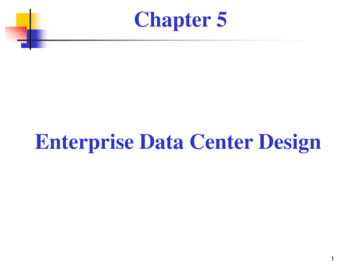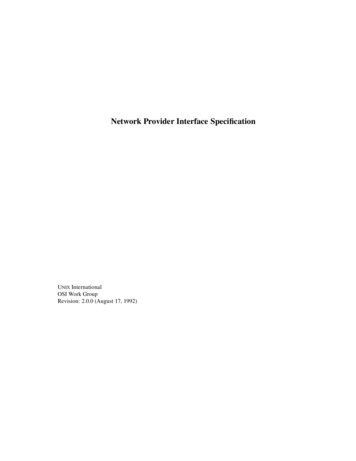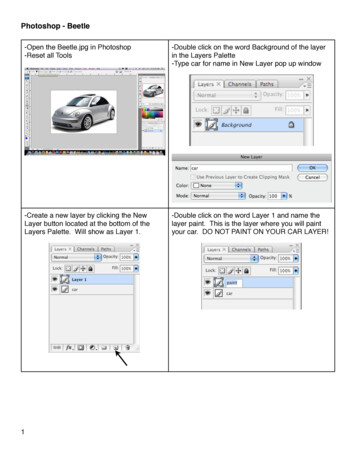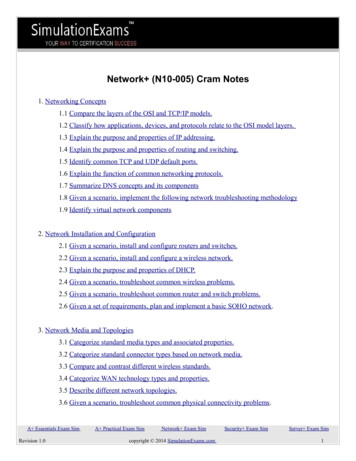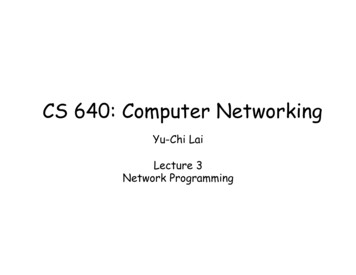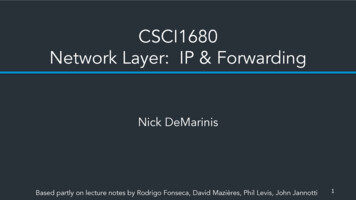
Transcription
CSCI1680Network Layer: IP & ForwardingNick DeMarinisBased partly on lecture notes by Rodrigo Fonseca, David Mazières, Phil Levis, John Jannotti1
Administivia Snowcast: was due last night HW1: Out now, due next Wed (Feb 23) IP Project: Out tomorrow (Feb 18)– Fill out group preference form by 11:59pm tomorrow (Feb 18)2
TodayStart of network layer Network layer: Internet Protocol (IP) (v4) Mechanics of IP forwarding Intro to IP project3
Layers, Services, ProtocolsApplicationService: user-facing application.Application-defined messagesTransportService: multiplexing applicationsReliable byte stream to other node (TCP),Unreliable datagram (UDP)NetworkService: move packets to any other node in the networkInternet Protocol (IP)LinkPhysicalService: move frames to other node across link.May add reliability, medium access controlService: move bits to other node across link
Internet Protocol (IP) GoalsHow to connect everyone? Glue lower-level networks together A network of networks! Router: device that forwardspackets between networksNetwork 1 (Ethernet)H1H2H7H3R3H8Network 4(point-to-point)Network 2 (Ethernet)R1Doesn’t this sound like switching?R2H4Network 3 (FDDI)H5H65
Inter-networking Challenges Networks are heterogeneous (eg. Wifi vs. Ethernet)– Different frame formats– Different service models– Different packet sizes/bandwidths Scaling– Link-layer forwarding strategiesdon’t scale to Internet!Network 1 (Ethernet)H1H2H7H3Network 4(point-to-point)Network 2 (Ethernet)R1R2H4Network 3 (FDDI)H5R3H6H8
Map of the Internet, 2021 (via BGP)OPTE project7
How would you design such a protocol? Circuits or packets?– Predictability Service model– Reliability, timing, bandwidth guarantees Any-to-any communication– How do you find a particular host?– How do you get a message there?– What happens when a host joins/leaves?
IP’s Decisions Packet switched– Unpredictability, statistical multiplexing Service model– Lowest common denominator: best effort, connectionlessdatagram Any-to-any communication– IP header: common message format– IP address: each host has an address, based on hierarchicalstructure of network
A Bit of History Packet switched networks: Arpanet’s IMPs– Late 1960’s– RFC 1, 1969!– Segmentation, framing, routing, reliability, reassembly, primitiveflow control Network Control Program (NCP)– Provided connections, flow control– Assumed reliable network: IMPs– Used by programs like telnet, mail, file transfer Wanted to connect multiple networks– Not all reliable, different formats, etc
TCP/IP Introduced Vint Cerf, Robert Kahn build protocol to replace NCP Initial design: single protocol providing a unified reliablepipe Different requirements soon emerged, and the two wereseparated– IP: basic datagram service among hosts– TCP: reliable transport– UDP: unreliable multiplexed datagram service
An excellent read David D. Clark, “The design Philosophy of the DARPA InternetProtocols”, 1988Primary goal: multiplexed utilization of existing interconnectednetworksOther goals:–––––––Communication continues despite loss of networks or gatewaysSupport a variety of communication servicesAccommodate a variety of networksPermit distributed management of its resourcesBe cost effectiveLow effort for host attachmentResources must be accountable
Internet ProtocolIP runs on all hosts and routers Provides addressing: how we name nodes in an IP network Provides forwarding: how routers move packets based on thedestination address Later: routing: how routers build forwarding PETHETH
IP’s Service Model Connectionless (datagram-based) Best-effort delivery (unreliable service)––––packets may be lostpackets may be delivered out of orderduplicate copies of packets may be deliveredpackets may be delayed for a long time It’s the lowest common denominator– A network that delivers no packets fits the bill!– All these can be dealt with above IP (if probability of delivery isnon-zero )
IP AddressingIP Version 4: Each address is a 32-bit number:128.148.16.710000000 10010100 00010000 00000111128.148.16.7Notation Write each byte (“octet”) as a decimal number This is called “dotted decimal” or ”dotted quad” notation17
IP AddressingAn IP address identifies Who a host is: A unique number Where it is on the Internet Networks are allocated ranges of IP128.148.16.7addresses by global authority (ICANN)– Further subdivided by regions, ISPs,organizations eg. Brown owns 128.148.xxx.xxx, 138.16.xxx.xxx*ICANN (Internet Corporation for Assigned Names and Numbers)18
IP AddressingBrown owns the range:128.148.xxx.xxx10000000 10010100 xxxxxxxx xxxxxxxxNetwork partIdentifies Brown (to the Internet)Host partDenotes individual hostswithin the Brown Network19
IP AddressingA network can designate IPaddresses for its own hosts within itsaddress rangeFor 128.148.xxx.xxx:10000000 10010100 xxxxxxxx xxxxxxxxBrown128.148.5.1Brown uses the the prefix 128.148.0.0/16Some other ways to write this:128.148/16128.148.0.0 subnet mask 255.255.0.0128.148.10.100128.148.200.520
Common prefixes1.2.0.0/1600000001 00000010 xxxxxxxx xxxxxxxx8.0.0.0/800001000 xxxxxxxx xxxxxxxx xxxxxxxx123.10.1.0/24201.112.10.200/3001111011 00001010 00000001 xxxxxxxx11001001 01110000 00001010 110010xx21
ExampleHow many addresses are in the network 192.1.0.0/20?22
How do we movepackets between networks?23
IP forwardingConsider the network 1.2.1.0/24: For IP, communicating on samenetwork is easy—this is the linklayer’s job! Need to map IP addresses toMAC addresses (more on thislater)reachtoothernetworks,send outsidepackets ToHowreachan addressa router, which forwardsthistonetwork?IP packets to other networks1.2.1.21.2.1.31.2.1.1 1.2.1.20024
Forwarding IP packetsSrc: 1.2.1.3Dst: 1.2.2.1001.2.1.2. . .To more networks (ie, 2.2.1051.2.1.20025
Forwarding IP packetsSrc: 1.2.1.3Dst: 1.2.2.1001.2.1.2 . . .To more networks (ie, 2.2.1051.2.1.20026
Forwarding IP packetsSrc: 1.2.1.3Dst: 1.2.2.1001.2.1.2 . . .To more networks (ie, efixInterface1.2.2.1051.2.1.20027
Forwarding IP packetsSrc: 1.2.1.3Dst: 1.2.2.1001.2.1.2 . . .To more networks (ie, 1.2.2.1PrefixInterface1.2.1.0/24IF11.2.2.0/24IF2 everything else IF01.2.2.10528
What about the rest?How to reach networks that aren’t directlyconnected?To more networks(ie, Internet)PrefixInterface1.2.1.0/24IF11.2.2.0/24IF2 everything else IF0IF0 8.0.0.11.2.1.0/24 IF1IF2 1.2.2.0/2429
What about the rest? Need IP of another router that knows aboutother networksThis “next hop” IP must be reachable locally!“Default” 0.0.0.0/0 refers to every address– Also called a gatewayPrefixIF/Next .0.0.28.0.0.28.0.0.11.2.1.0/24 IF1IF0IF2 1.2.2.0/2430
The forwarding table Exploits hierarchical structure of addresses: know how to reachnetworks, not individual hostsPrefixIF/Next .0.0.2Table is keyed is a network prefix, not a whole addressSelect best prefix with longest prefix matching (more on this later)31
A forwarding table# ip route127.0.0.0/8 via 127.0.0.1 dev lo172.17.44.0/24 dev enp7s0 proto kernel scope link src 172.17.44.22default via 172.17.44.1 dev eth0 src 172.17.44.22 metric 204metric 20432
The IPv4 HeaderDefined by RFC 791RFC (Request for Comment): defines network standard33
Important fields Version: 4 for IPv4 packets, 6 for IPv6 Destination address: used for forwarding TTL (time-to-live): decremented each hop– Can prevent forwarding loops (and do other stuff ) Checksum: computed over header (very weak!) Protocol identifier: describes what’s in the packet– 6: TCP, 17: UDP, 1: ICMP, – Defines the type of the payload34
Less important fields Header length: in 32-bit units– 5 implies use of IP options– Almost all routers ignore IP options Fragmentation– Network can fragment a packet if next link requires a small frame– Most routers don’t fragment (or reassemble fragments) We won’t talk about – Type of Service (TOS): basic traffic classification– Identifier: might have special meaning on some networks35
Forwarding mechanicsWhen an IP packet arrives at a host/router: Is it valid? Verify checksum over header Is it for me? If dest IP your address, send to OS If not, where should it go?– Consult forwarding table find next hop– Decrement TTL– Send packet to next hop36
Traceroute When TTL reaches 0, router may send back an error– ICMP TTL exceeded If it does, we can identify a path used by a packet!37
Coming up ARP: Mapping IPs to MAC addressesHow are addresses assigned?NAT: When it gets complicatedRouting algorithms: how to build forwarding tablesFill out the group preference survey for the IPproject (announcement soon) by tomorrow (Feb18) by 11:59PM38
Putting it all together PrefixInterface.1.2.1.31.2.0.0/161.2.0.1 via IF42142.0.0/85.0.0.5 via IF21.142.250.65.206 The more connected a router becomes, the more complex itsforwarding table and the more it may change! Routing algorithms: routers exchange path information to theirforwarding tables (more on this later)39
Goal: find the most specific(ie, longest) prefix matching thedestinationHow to reach .2.0/24IF20.0.0.0/0 everything else IF01.2.1.0/2400000001.00000010.00000010.01100100? xxxxxx.xxxxxxxx.xxxxxxxxLongest Prefix Matching (LPM): can represent entireIP space in (small) table!Output: IF240
8.0.0.0/30Some ISPBrown128.148.0.0/16Dst: 128.148.105.207. . .Dst: 128.148.100.104. . .Customer 21.3.0.0/16Customer .148.100.0/24IF40.0.0.0/08.0.0.241
A large tablerviews@route-server.ip.att.net show route table inet.0 active-pathinet.0: 866991 destinations, 13870153 routes (866991 active, 0 holddown, 0 hidden) Active Route, - Last Active, * /241.0.6.0/24*[Static/5] 5w0d 19:43:09 to 12.0.1.1 via em0.0*[BGP/170] 1d 10:24:47, localpref 100, from 12.122.83.238AS path: 7018 3356 13335 I, validation-state: valid to 12.0.1.1 via em0.0*[BGP/170] 1d 10:24:47, localpref 100, from 12.122.83.238AS path: 7018 3356 4826 38803 I, validation-state: valid to 12.0.1.1 via em0.0*[BGP/170] 1d 10:24:47, localpref 100, from 12.122.83.238AS path: 7018 3356 4826 38803 I, validation-state: valid to 12.0.1.1 via em0.0*[BGP/170] 1d 10:24:47, localpref 100, from 12.122.83.238AS path: 7018 3356 4826 38803 I, validation-state: valid to 12.0.1.1 via em0.0*[BGP/170] 1d 10:24:47, localpref 100, from 12.122.83.238AS path: 7018 3356 4826 38803 I, validation-state: valid42
How to avoid loops?TTL (Time to Live): Decrement by 1 ateach hop, send back error at 0traceroute: tool to send packets with increasing TTLs can learn about network paths!44
Traceroute example[deemer@Warsprite ] traceroute -q 1 google.comtraceroute to google.com (142.251.40.174), 30 hops max, 60 byte packets1 router1-nac.linode.com (207.99.1.13) 0.621 ms2 if-0-1-0-0-0.gw1.cjj1.us.linode.com (173.255.239.26) 0.499 ms3 72.14.222.136 (72.14.222.136) 0.949 ms4 72.14.222.136 (72.14.222.136) 0.919 ms5 108.170.248.65 (108.170.248.65) 1.842 ms6 lga25s81-in-f14.1e100.net (142.251.40.174) 1.812 ms45
Traceroute example[deemer@Warsprite ] traceroute -q 1 amazon.co.uktraceroute to amazon.co.uk (178.236.7.220), 30 hops max, 60 byte packets1 router2-nac.linode.com (207.99.1.14) 0.577 ms2 if-11-1-0-1-0.gw2.cjj1.us.linode.com (173.255.239.16) 0.461 ms3 ix-et-2-0-2-0.tcore3.njy-newark.as6453.net (66.198.70.104) 1.025 ms4 be3294.ccr41.jfk02.atlas.cogentco.com (154.54.47.217) 2.938 ms5 be2317.ccr41.lon13.atlas.cogentco.com (154.54.30.186) 69.725 ms6 be2350.rcr21.b023101-0.lon13.atlas.cogentco.com (130.117.51.138) 69.947 ms7 a100-row.demarc.cogentco.com (149.11.173.122) 71.639 ms8 150.222.15.28 (150.222.15.28) 78.217 ms9 150.222.15.21 (150.222.15.21) 84.383 ms10 *11 150.222.15.4 (150.222.15.4) 74.529 ms. . .30 178.236.14.162 (178.236.14.162) 83.659 ms46
47
Based partly on lecture notes by Rodrigo Fonseca, David Mazières, Phil Levis, John Jannotti 1. Administivia Snowcast: was due last night HW1:Out now, due nextWed (Feb 23) IPProject: Out tomorrow (Feb 18) -Fill out grouppreferenceform by 11:59pm tomorrow (Feb 18) 2. Today

